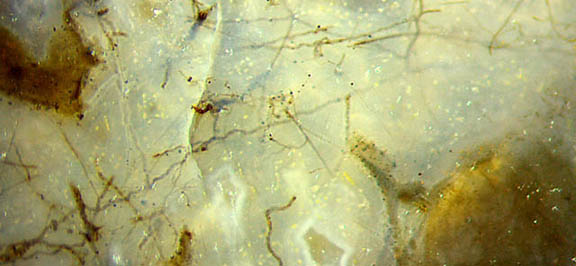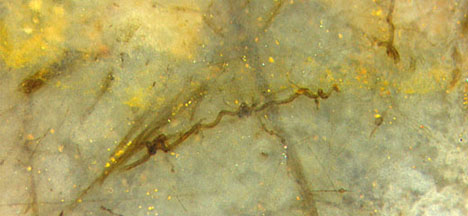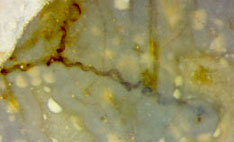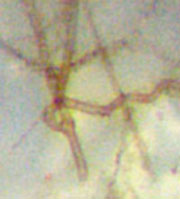Fossil mycoparasite like
extant Trichoderma
 Fungus hyphae in Rhynie chert are often
surprisingly straight
(Fig.1). Hence, wavy or curly
hyphae grown along straight ones come
as another surprise (Figs.2,3). This phenomenon
is known from the thoroughly investigated
extant fungus Trichoderma,
some of whose species can turn to a parasitic way
of life [1]. So it
can be assumed that the wavy fossil hyphae
most probably are parts of
a parasitic fungus with a similar way of nutrient uptake
from the host as known
from the extant Trichoderma.
Fungus hyphae in Rhynie chert are often
surprisingly straight
(Fig.1). Hence, wavy or curly
hyphae grown along straight ones come
as another surprise (Figs.2,3). This phenomenon
is known from the thoroughly investigated
extant fungus Trichoderma,
some of whose species can turn to a parasitic way
of life [1]. So it
can be assumed that the wavy fossil hyphae
most probably are parts of
a parasitic fungus with a similar way of nutrient uptake
from the host as known
from the extant Trichoderma.
Fig.1: Fungus hyphae, or fused bundles thereof,
of
mainly straight aspect. Width of the image 4mm.
Fig.2-5: Irregularly wavy parasitic
hyphae grown along straight ones.
Width of the images 3.2mm, 2.6mm, 1.3mm, 1.3mm.
Same scale as
Fig.1.



 This fossil evidence is compatible with recent
observations on Trichoderma
but one fossil structure has been found which indicates that the matter
is more complex than a wavy parasite clinging to a straight hypha, as on
the left of Fig.5,
enlarged in Fig.6.
This fossil evidence is compatible with recent
observations on Trichoderma
but one fossil structure has been found which indicates that the matter
is more complex than a wavy parasite clinging to a straight hypha, as on
the left of Fig.5,
enlarged in Fig.6. 
Fig.6 (right): Detail of
Fig.5, same sample as Fig.1.
Width of the image 0.18mm.
An
irregularly wavy hypha is seen connected to a straight one. What has
been going on here is far from obvious. According to [1], "Trichoderma
coils around or grows along the host hyphae" upon contact but no host
hypha is near which could have induced the waviness in Figs.5,6.
Perhaps
the
host hypha has become completely "eaten up" by the parasite, as it is
known from Trichoderma
species.
The hyphae resembling Trichoderma
have
been taken from 4 chert
samples. Apparently they serve as first fossil evidence of Trichoderma and of the
conclusion drawn from genome sequence analysis [2]: "Mycoparasitism is
an ancient life style of Trichoderma."
Trichoderma
species are commercially grown and
successfully used in plant protection [1,2]. This is briefly mentioned
in [3] without reference to wavy fossil hyphae.
"T. virens
possesses combinations of traits within
a single organism that are usually associated with distinct species of
symbionts or pathogens" [4]. From the similar aspect of the fossil fungi in these pictures and T. virens in [4] it may be concluded that the ancient species,
too, possibly possessed this peculiar combination of traits.
H.-J. Weiss 2017
[1] K.E. Borkovich,
D.J. Ebbole:
Filamentous Fungi. ASM Press 2010, p.676.
[2] C.P. Kubicek:
Comparative genome sequence analysis underscores mycoparasitism as the
ancestral life style of Trichoderma.
Genome Biol. 2011; 12(4): R40.
[3] T.N. Taylor, M. Krings,
E.L. Taylor: Fossil Fungi,
Elsevier 2015, p.251.
[4] Google: jgi mycocosm trichoderma virens
 |
 |
109 |


 Fungus hyphae in Rhynie chert are often
surprisingly straight
(Fig.1). Hence, wavy or curly
hyphae grown along straight ones come
as another surprise (Figs.2,3). This phenomenon
is known from the thoroughly investigated
extant fungus Trichoderma,
some of whose species can turn to a parasitic way
of life [1]. So it
can be assumed that the wavy fossil hyphae
most probably are parts of
a parasitic fungus with a similar way of nutrient uptake
from the host as known
from the extant Trichoderma.
Fungus hyphae in Rhynie chert are often
surprisingly straight
(Fig.1). Hence, wavy or curly
hyphae grown along straight ones come
as another surprise (Figs.2,3). This phenomenon
is known from the thoroughly investigated
extant fungus Trichoderma,
some of whose species can turn to a parasitic way
of life [1]. So it
can be assumed that the wavy fossil hyphae
most probably are parts of
a parasitic fungus with a similar way of nutrient uptake
from the host as known
from the extant Trichoderma.


 This fossil evidence is compatible with recent
observations on Trichoderma
but one fossil structure has been found which indicates that the matter
is more complex than a wavy parasite clinging to a straight hypha, as on
the left of Fig.5,
enlarged in Fig.6.
This fossil evidence is compatible with recent
observations on Trichoderma
but one fossil structure has been found which indicates that the matter
is more complex than a wavy parasite clinging to a straight hypha, as on
the left of Fig.5,
enlarged in Fig.6. 

